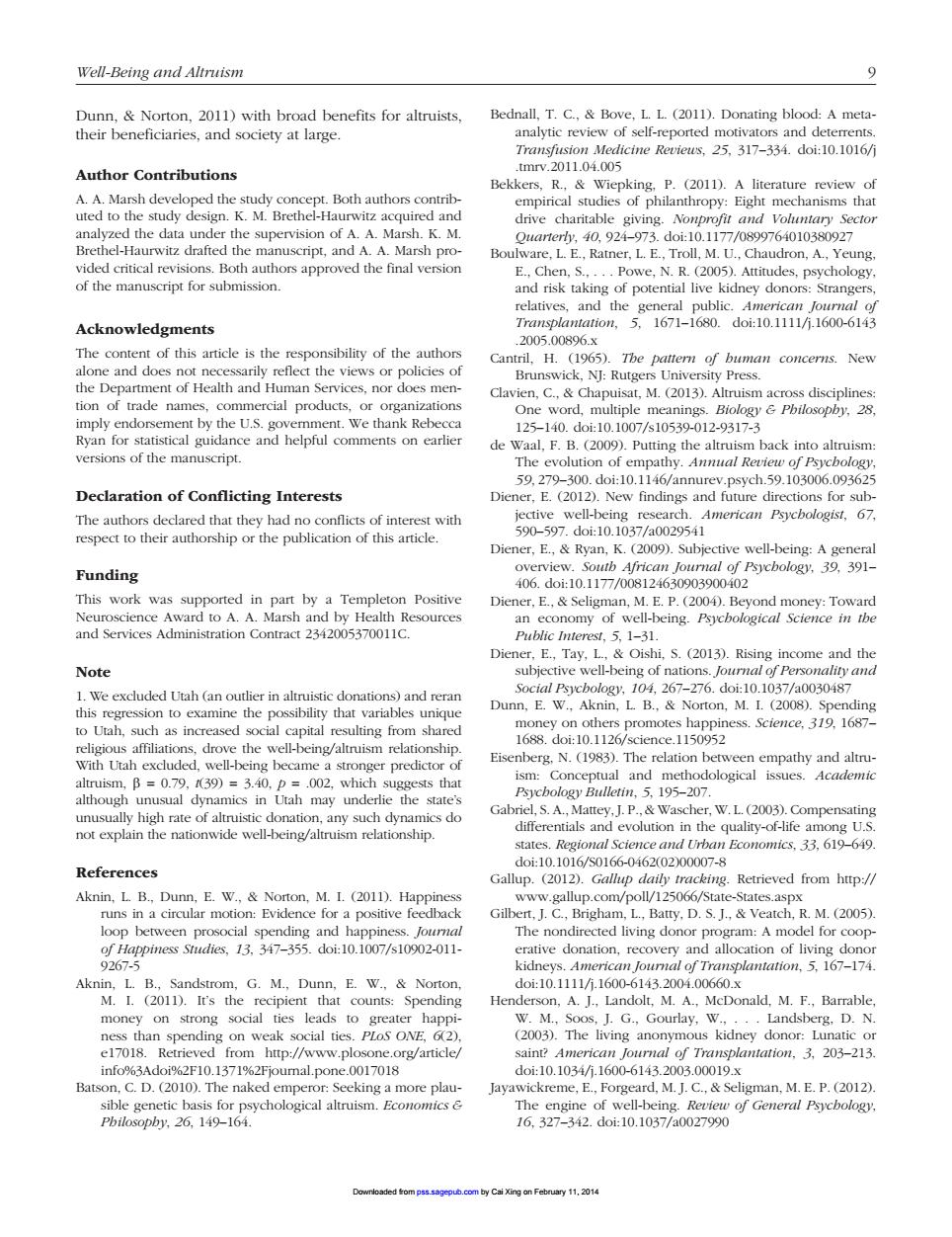正在加载图片...

Well-Being and Altruism .9 Dunn,Norton,2011)with broad benefits for altruists, their beneficiaries,and society at large Transfusion Medicine Revieus,25,317-334.doi:10.1016/ Author Contributions 011.04.00 p(2011).A1it Boulwvare.L Ratner,LE Troll.M.U.Chaudron,A.Yeung of the manuscript for submission. and risk taking nal o Acknowledgments 2005.00s96o d -61 of this Cantril.H.(5).The buman.New n C Chapu M2013)Am discipline nent.We thank Rebecca nings.Bi ology Pbilosopby,28, m de w m back into altruism Declaration of Conflicting Interests Diener.E.(2012).New findingsand future directions for sub American Psycbologist,67. Diener.E.Ryan.K.(2009).Subjective well-being:A general Funding This work was supported in part by a Templeton Positive Diener,E..Tay. .Oishi,S.(2013).Rising income and the Note 1.We excluded Utah (an outlier in altruistic donations)and reran ty that va les unique 16 doi:1012 Eisenberg.N.(1983).The relation be n empathy and altru cam 02 dymamis in ith wuderte ssues.Academi Gabriel,.A.Mattey,J.P.&Wascher,W.L(2005).Compensatin References dot:10.1016/S016-04620200007- ed from hup:/ Aknin.L.B.Dunn.E.W..Norton.M.I.(2011).Hap com//s-Sa erative donation.re and allocation of liv .A.I..Landolt,M.A..McDonald,M.F Barrable e17018.Retrieved from htp://www.plo .13719 Bats E1600-61 M5.00019 012 or e of f well-bx of General Psycbology Pbilo 16.0 11.2014 Well-Being and Altruism 9 Dunn, & Norton, 2011) with broad benefits for altruists, their beneficiaries, and society at large. Author Contributions A. A. Marsh developed the study concept. Both authors contributed to the study design. K. M. Brethel-Haurwitz acquired and analyzed the data under the supervision of A. A. Marsh. K. M. Brethel-Haurwitz drafted the manuscript, and A. A. Marsh provided critical revisions. Both authors approved the final version of the manuscript for submission. Acknowledgments The content of this article is the responsibility of the authors alone and does not necessarily reflect the views or policies of the Department of Health and Human Services, nor does mention of trade names, commercial products, or organizations imply endorsement by the U.S. government. We thank Rebecca Ryan for statistical guidance and helpful comments on earlier versions of the manuscript. Declaration of Conflicting Interests The authors declared that they had no conflicts of interest with respect to their authorship or the publication of this article. Funding This work was supported in part by a Templeton Positive Neuroscience Award to A. A. Marsh and by Health Resources and Services Administration Contract 2342005370011C. Note 1. We excluded Utah (an outlier in altruistic donations) and reran this regression to examine the possibility that variables unique to Utah, such as increased social capital resulting from shared religious affiliations, drove the well-being/altruism relationship. With Utah excluded, well-being became a stronger predictor of altruism, β = 0.79, t(39) = 3.40, p = .002, which suggests that although unusual dynamics in Utah may underlie the state’s unusually high rate of altruistic donation, any such dynamics do not explain the nationwide well-being/altruism relationship. References Aknin, L. B., Dunn, E. W., & Norton, M. I. (2011). Happiness runs in a circular motion: Evidence for a positive feedback loop between prosocial spending and happiness. Journal of Happiness Studies, 13, 347–355. doi:10.1007/s10902-011- 9267-5 Aknin, L. B., Sandstrom, G. M., Dunn, E. W., & Norton, M. I. (2011). It’s the recipient that counts: Spending money on strong social ties leads to greater happiness than spending on weak social ties. PLoS ONE, 6(2), e17018. Retrieved from http://www.plosone.org/article/ info%3Adoi%2F10.1371%2Fjournal.pone.0017018 Batson, C. D. (2010). The naked emperor: Seeking a more plausible genetic basis for psychological altruism. Economics & Philosophy, 26, 149–164. Bednall, T. C., & Bove, L. L. (2011). Donating blood: A metaanalytic review of self-reported motivators and deterrents. Transfusion Medicine Reviews, 25, 317–334. doi:10.1016/j .tmrv.2011.04.005 Bekkers, R., & Wiepking, P. (2011). A literature review of empirical studies of philanthropy: Eight mechanisms that drive charitable giving. Nonprofit and Voluntary Sector Quarterly, 40, 924–973. doi:10.1177/0899764010380927 Boulware, L. E., Ratner, L. E., Troll, M. U., Chaudron, A., Yeung, E., Chen, S., . . . Powe, N. R. (2005). Attitudes, psychology, and risk taking of potential live kidney donors: Strangers, relatives, and the general public. American Journal of Transplantation, 5, 1671–1680. doi:10.1111/j.1600-6143 .2005.00896.x Cantril, H. (1965). The pattern of human concerns. New Brunswick, NJ: Rutgers University Press. Clavien, C., & Chapuisat, M. (2013). Altruism across disciplines: One word, multiple meanings. Biology & Philosophy, 28, 125–140. doi:10.1007/s10539-012-9317-3 de Waal, F. B. (2009). Putting the altruism back into altruism: The evolution of empathy. Annual Review of Psychology, 59, 279–300. doi:10.1146/annurev.psych.59.103006.093625 Diener, E. (2012). New findings and future directions for subjective well-being research. American Psychologist, 67, 590–597. doi:10.1037/a0029541 Diener, E., & Ryan, K. (2009). Subjective well-being: A general overview. South African Journal of Psychology, 39, 391– 406. doi:10.1177/008124630903900402 Diener, E., & Seligman, M. E. P. (2004). Beyond money: Toward an economy of well-being. Psychological Science in the Public Interest, 5, 1–31. Diener, E., Tay, L., & Oishi, S. (2013). Rising income and the subjective well-being of nations. Journal of Personality and Social Psychology, 104, 267–276. doi:10.1037/a0030487 Dunn, E. W., Aknin, L. B., & Norton, M. I. (2008). Spending money on others promotes happiness. Science, 319, 1687– 1688. doi:10.1126/science.1150952 Eisenberg, N. (1983). The relation between empathy and altruism: Conceptual and methodological issues. Academic Psychology Bulletin, 5, 195–207. Gabriel, S. A., Mattey, J. P., & Wascher, W. L. (2003). Compensating differentials and evolution in the quality-of-life among U.S. states. Regional Science and Urban Economics, 33, 619–649. doi:10.1016/S0166-0462(02)00007-8 Gallup. (2012). Gallup daily tracking. Retrieved from http:// www.gallup.com/poll/125066/State-States.aspx Gilbert, J. C., Brigham, L., Batty, D. S. J., & Veatch, R. M. (2005). The nondirected living donor program: A model for cooperative donation, recovery and allocation of living donor kidneys. American Journal of Transplantation, 5, 167–174. doi:10.1111/j.1600-6143.2004.00660.x Henderson, A. J., Landolt, M. A., McDonald, M. F., Barrable, W. M., Soos, J. G., Gourlay, W., . . . Landsberg, D. N. (2003). The living anonymous kidney donor: Lunatic or saint? American Journal of Transplantation, 3, 203–213. doi:10.1034/j.1600-6143.2003.00019.x Jayawickreme, E., Forgeard, M. J. C., & Seligman, M. E. P. (2012). The engine of well-being. Review of General Psychology, 16, 327–342. doi:10.1037/a0027990 Downloaded from pss.sagepub.com by Cai Xing on February 11, 2014